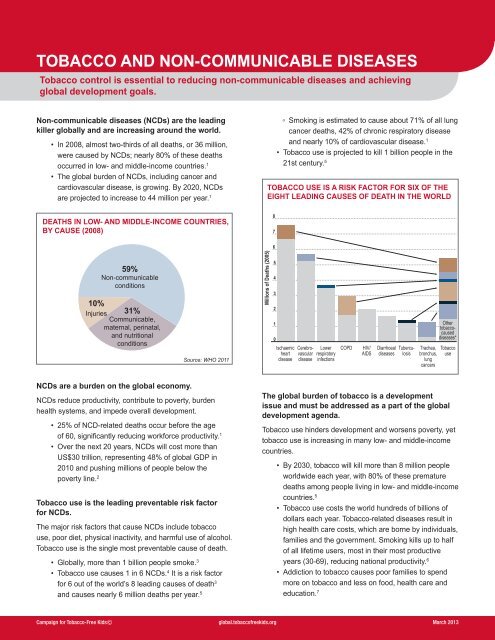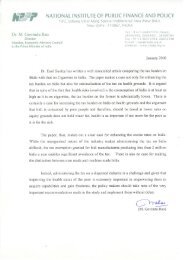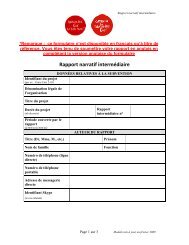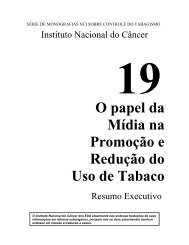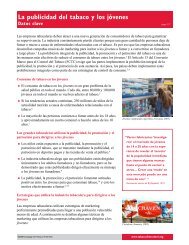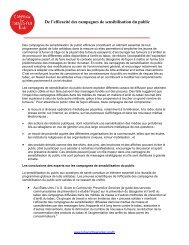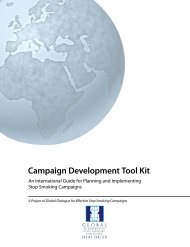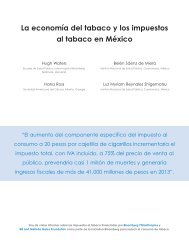TOBACCO AND NON-COMMUNICABLE DISEASES - Campaign for ...
TOBACCO AND NON-COMMUNICABLE DISEASES - Campaign for ...
TOBACCO AND NON-COMMUNICABLE DISEASES - Campaign for ...
You also want an ePaper? Increase the reach of your titles
YUMPU automatically turns print PDFs into web optimized ePapers that Google loves.
<strong>TOBACCO</strong> <strong>AND</strong> <strong>NON</strong>-<strong>COMMUNICABLE</strong> <strong>DISEASES</strong>Tobacco control is essential to reducing non-communicable diseases and achievingglobal development goals.Non-communicable diseases (NCDs) are the leadingkiller globally and are increasing around the world.• In 2008, almost two-thirds of all deaths, or 36 million,were caused by NCDs; nearly 80% of these deathsoccurred in low- and middle-income countries. 1• The global burden of NCDs, including cancer andcardiovascular disease, is growing. By 2020, NCDsare projected to increase to 44 million per year. 1◦◦Smoking is estimated to cause about 71% of all lungcancer deaths, 42% of chronic respiratory diseaseand nearly 10% of cardiovascular disease. 1• Tobacco use is projected to kill 1 billion people in the21st century. 5<strong>TOBACCO</strong> USE IS A RISK FACTOR FOR SIX OF THEEIGHT LEADING CAUSES OF DEATH IN THE WORLDDEATHS IN LOW- <strong>AND</strong> MIDDLE-INCOME COUNTRIES,BY CAUSE (2008)87659%Non-communicableconditions10%Injuries 31%Communicable,maternal, perinatal,and nutritionalconditionsSource: WHO 2011Millions of Deaths (2005)543210IschaemicheartdiseaseCerebrovasculardiseaseLowerrespiratoryinfectionsCOPDHIV/AIDSDiarrhoealdiseasesTuberculosisOthertobaccocauseddiseases*Trachea, Tobaccobronchus, uselungcancersNCDs are a burden on the global economy.NCDs reduce productivity, contribute to poverty, burdenhealth systems, and impede overall development.• 25% of NCD-related deaths occur be<strong>for</strong>e the ageof 60, significantly reducing work<strong>for</strong>ce productivity. 1• Over the next 20 years, NCDs will cost more thanUS$30 trillion, representing 48% of global GDP in2010 and pushing millions of people below thepoverty line. 2Tobacco use is the leading preventable risk factor<strong>for</strong> NCDs.The major risk factors that cause NCDs include tobaccouse, poor diet, physical inactivity, and harmful use of alcohol.Tobacco use is the single most preventable cause of death.• Globally, more than 1 billion people smoke. 3• Tobacco use causes 1 in 6 NCDs. 4 It is a risk factor<strong>for</strong> 6 out of the world’s 8 leading causes of death 3and causes nearly 6 million deaths per year. 5The global burden of tobacco is a developmentissue and must be addressed as a part of the globaldevelopment agenda.Tobacco use hinders development and worsens poverty, yettobacco use is increasing in many low- and middle-incomecountries.• By 2030, tobacco will kill more than 8 million peopleworldwide each year, with 80% of these prematuredeaths among people living in low- and middle-incomecountries. 5• Tobacco use costs the world hundreds of billions ofdollars each year. Tobacco-related diseases result inhigh health care costs, which are borne by individuals,families and the government. Smoking kills up to halfof all lifetime users, most in their most productiveyears (30-69), reducing national productivity. 6• Addiction to tobacco causes poor families to spendmore on tobacco and less on food, health care andeducation. 7<strong>Campaign</strong> <strong>for</strong> Tobacco-Free Kids©global.tobaccofreekids.orgMarch 2013
<strong>TOBACCO</strong> <strong>AND</strong> <strong>NON</strong>-<strong>COMMUNICABLE</strong> <strong>DISEASES</strong>Progress: The Framework Convention on TobaccoControl (FCTC)The Political Declaration adopted at the United NationsHigh-Level Meeting on Non-Communicable Diseases(NCDs) in September 2011 calls on nations to accelerateimplementation of the Framework Convention on TobaccoControl (FCTC), highlighting the effectiveness of raisingtaxes on tobacco products to prevent NCDs.The Framework Convention on Tobacco Control, theworld’s first public health treaty, establishes specific stepsgovernments must take to reduce tobacco use. As ofJune 2012, more than 176 Parties have ratified the FCTC.Governments commit to establishing policies to reducetobacco use when they ratify the treaty, including:• Adopting tax and price measures to reducetobacco consumption;• Banning tobacco advertising, promotion andsponsorship;• Creating smoke-free work and public spaces;• Putting prominent health warnings on tobaccopackages.Tobacco control is a cost-effective and feasibleintervention to address the NCD epidemic.Governments must prioritize tobacco control andimplementation of the FCTC to reduce tobacco useand the global burden of NCDs, save lives and benefittheir country’s economy.• Full implementation of the FCTC would avert5.5 million deaths over 10 years in 23 lowandmiddle-income countries with a high burdenof NCD. 4• The scale-up of tobacco control measureswould cost: 8◦◦US$ 620 million per year <strong>for</strong> all low- andmiddle-income countries combined, orUS$ 0.11 per person per year.◦◦US$ 0.05 per person per year in low-incomecountries.◦◦US$ 0.15 per person per year in upper-middleincome countries.KEY MESSAGES■■Non-communicable diseases (NCDs) are the leading causes of death in the world.■■NCDs burden health systems, reduce productivity, and can cause poverty.■■Tobacco use is the leading preventable risk factor <strong>for</strong> NCDs.■ ■ Tackling the NCD epidemic through the full implementation of the FCTC is bothcost-effective and feasible.(1) World Health Organization. Global Status Report on Non-Communicable Diseases. Geneva: WHO; 2011. (2) World Economic Forum, Harvard School of Public Health. TheGlobal Economic Burden of Non-Communicable Diseases. Geneva: World Economic Forum; 2011. (3) World Health Organization. WHO report on the global tobacco epidemic,2008 - The MPOWER package. Geneva: World Health Organization; 2008. (4) Beaglehole R, Bonita R, Horton R, Adams C, Alleyne G, Asaria P, et al. Priority actions <strong>for</strong> the noncommunicabledisease crisis. Lancet. 2011 Apr 23;377(9775):1438-47. (5) World Health Organization. WHO report on the global tobacco epidemic, 2011: warning about the dangersof tobacco. Geneva: World Health Organization; 2011. (6) Mackay J, Eriksen MP, Shafey O. The tobacco atlas, 2nd edition. Atlanta: American Cancer Society; 2006. (7) World HealthOrganization. Tobacco Free Initiative: Why tobacco is a public health priority. [cited 2011 Sept 26]; Available from who.int/tobacco/health_priority/en/ (8) World Health Organization.Estimation of Resource Needs and Costs <strong>for</strong> Scaling-up a Core Non-Communicable Disease Intervention Package in Low and Middle-income Countries. Geneva: World HealthOrganization; 2011.<strong>Campaign</strong> <strong>for</strong> Tobacco-Free Kids©global.tobaccofreekids.orgMarch 2013


